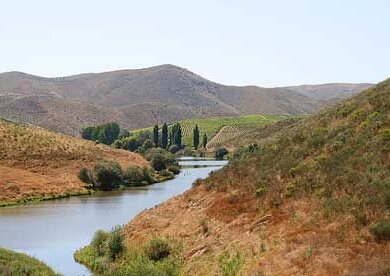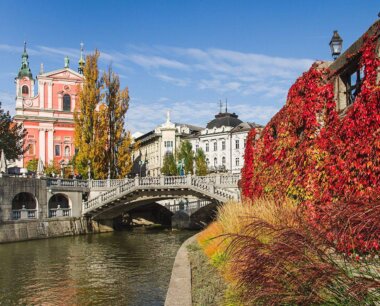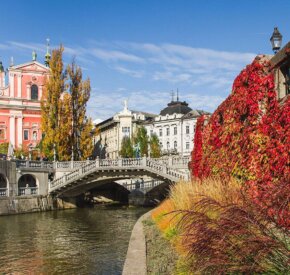
Unearthing the rock art of Portugal’s Coa Valley
A trip to this scenic backwater reveals how a multi-million dollar dam project was halted to preserve this now-UNESCO World Heritage site
On the banks of the River Côa a hard morning’s hunting had come to an end, and a group of locals lit a fire to barbecue the quarry. After lunch, they sharpened some hunks of flint for a spot of etching on the vertical walls of schistous rock that lined their valley, carving images of the cattle-like aurochs and ibex they’d preyed on.
Some 24,000 years later, their descendants resolved to preserve for posterity the fruits of these creative impulses by abandoning a half-built hydroelectric project.
Snaking through the Côa valley
Angela Ferreira, my guide to the Foz Côa Archaeological Park, appeared as agile as an ibex herself as she skipped up the rock face to point out the engravings’ outlines. By adding plausible details to the archaeological facts, she sent my imagination roaming over aeons.“The Palaeolithic people who first engraved figures here were the start of a long, long tradition. When I show you how long, you will be astonished,” promised Angela.
The Côa valley, in the Alto Douro region of north-east Portugal, must count as one of the furthest-flung corners of Western Europe. The hilly landscape is painted from an amazing palette: glossy citrus groves, silvery olive trees and neat rows of vines streaming like tresses of green hair, sliced through by the harrowing gorge of the River Côa.
The romantic way to get there would be to ride the single-track railway from Porto at the mouth of the Douro. The train snakes along the water’s edge, crossing from the north bank to the south and passing five massive dams, which, in the 1970s, transformed the Douro from tortuous rapids and whirlpools into a series of placid, serpentine lakes.
However, on a weekend trip I found it more practical to hire a car at Porto airport and drive for half a day to Pocinho, at the Côa’s confluence with the Douro, 15km short of the Spanish border. From here, I snaked up the tributary to the park.
Saved from destruction
Until 1991, this was a backwater forgotten by all except the port company Ramos Pinto, which grew some of its finest grapes along the banks of the Côa, and EPD, the Portuguese electricity company that was turning its attention to the Douro’s tributaries. Work began that year on a 100m-high dam in a gorge near the Côa’s mouth. Four years and more than £200 million later, the project was abandoned.
Ramos Pinto winemaker João Nicolau de Almeida, who was at the vanguard of the fight against the dam, told me: “Rock engravings were discovered during a study into the dam’s environmental impact. It became apparent that there were tens of thousands of them, and that the Côa Valley was one of the world’s most important Palaeolithic sites. For us, this was a miracle. It forced the government to stop the dam and the valley was saved from flooding.”
Instead, a flood of excited archaeologists made their way to the Côa Valley, which was eventually declared a Unesco World Heritage site. This in turn brought EU funding for the newly formed Foz Côa Archaeological Park.
I met Angela in Muxagata, a rustic farming village with a medieval pillory on the cobbled main square. Opposite, the old granite prison has become one of several visitor centres for the park, with air conditioning, banks of computer terminals and wall displays.
The 4 sq km of the valley floor where most of the engravings are found is accessible only with a guide, in one of the park’s 4WD vehicles. With Angela at the wheel we lurched along a rough track, fording the Côa a couple of times and stopping to view the staggeringly profuse engravings along 20km of the valley.
“There may be as many as 12,000 of them, and archaeologists are finding their assumptions about the origins and development of primitive art challenged,” Angela said.
Artistic appreciation
To the untutored eye it was hard to make head or tail of the overlapping lines, etched indelibly into the rock. They could easily be mistaken for scars of erosion and weather. But using a crib file with shapes outlined in different colours, Angela was able to show how these were engravings of fish, bulls and horses, as well as aurochs (long since extinct) and ibex.
Using colours to demonstrate styles and genres across the ages, I learned how later Stone Age cultures had added two or three heads to their creatures to represent movement. Throughout the Bronze and Iron Ages the rock art continued, with figures depicting humans in graceful motion. There was even some frolicsome soft porn – earnestly presented as a fertility symbol, of course.
What I found bizarre was that although only ‘discovered’ recently, these engravings were never lost to human knowledge at all. To local farmers and shepherds, the engravings were things they had grown up with, but had never considered significant.
While it is the prehistoric works that had the power to stop the hydroelectric project, there are also Roman ones, crosses and grails from the Middle Ages, and – in fulfilment of Angela’s promise to astonish – a steam engine crossing a bridge, signed and dated 1944 by the artist.
Bring on the water works
At the bottom of the valley is the half-built dam, which was to have spanned an immensely high, narrow cleft in the rock. On the lip there is an abandoned cement works and prefab village where the construction workers were billeted. As I watched a falcon swoop under a cable bridge, only the echo of distant running water broke the eerie silence.
Back at the park’s headquarters at Vila Nova de Foz Côa, I met the director, Fernando Maia Pinto, who showed me his elaborate plans for the future. Underwater surveys have uncovered the presence of thousands more engravings on the lower reaches of the Côa, beneath the level flooded by a dam on the Douro.
How to save them for eternity? Build a pair of dams at either end of this stretch, and drain it; a tunnel will carry the Côa between the two. About £5 million should do the trick, and all that needs to be done is persuade the EU to pick up the tab.
“This will be an excellent investment, as well as important for archaeology,” Maia Pinto told me confidently as he showed off a mock-up of a passenger terminal for the cruise boats that already ply the Douro. “Visitors will eat, drink and spend their money on souvenirs of what will soon be recognised as a wonder of the archaeological world.”
Under threat
Driving back towards Porto, I stopped at Tua in the heart of port country. In contrast with the fine old stone houses of the quintas (estates), Tua consists of a few scruffy houses scattered about the station. A steam engine sits in a siding, rusting and neglected. This is the locomotive that retired 25 years ago in favour of a diesel engine on the narrow-gauge branch line up the Tua tributary.
According to rumour, the Tua is the next target for a hydroelectric dam. Some say work will start next year, others that it won’t be for at least a decade. However, if it does go ahead, this romantic little line will be a certain casualty. Locals who love it should be scouring the banks for Palaeolithic engravings.




















